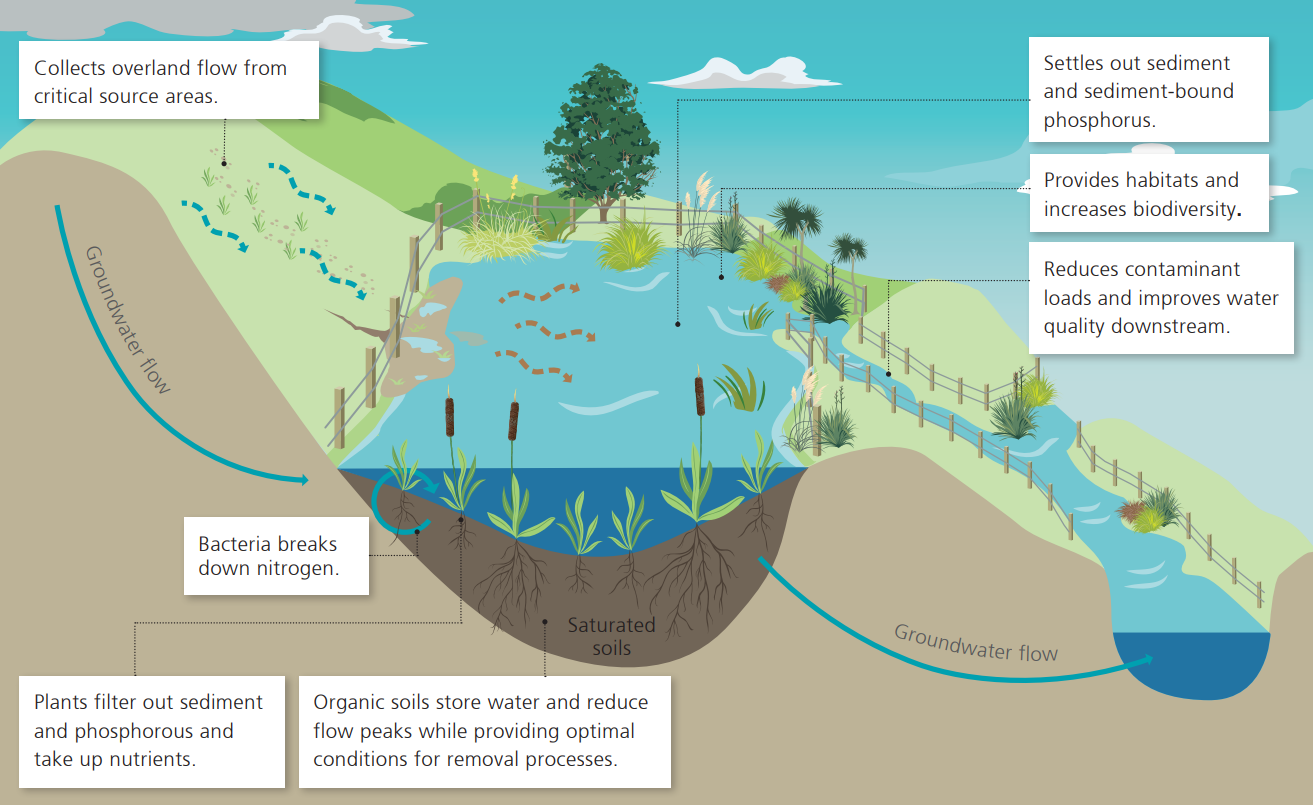Wetlands
3 min read
New Zealand has lost 90 percent of its wetland areas due to drainage, land development and land use change. Protecting, restoring and creating wetlands on-farm can reduce nutrient and contaminant loss, decrease the impact of floods and provide valuable habitat for native plants and animals.
All the permanent or seasonally wet areas of your farm are small natural wetlands, including:
Bogs: receive all their water from rain, so are not enriched by nutrients from adjacent land or underlying mineral soils. Being almost constantly waterlogged, they are poorly aerated and usually acidic.
Swamps: fertile wetlands that are fed by both groundwater and surface runoff so receive a regular supply of nutrients and sediment from adjacent land.
Seeps: occur at the bottom of hill slopes where groundwater comes to the surface. Can be permanent or seasonal and exist on all soil types. Can be nutrient-rich because they receive runoff from paddocks and often cows have direct access to them. Losses of sediment and E. coli to water from these areas can be significant during rainfall or overland flow.
Wet areas in paddocks: swampy or boggy places where drainage is poor, such as hollow or valley bottoms. Could be fed by rainfall or high water table and tend to be on heavier soils. Risk of overland flow to waterways is less as they are often not connected to waterways, although they are still nutrient ‘hotspots’.
Riparian wetlands: wet or boggy places bordering waterways, drains, and lakes. Can be nutrient-rich, like seeps, and risk sediment and E. coli loss to waterways.
Wetlands have an important part to play in reducing our environmental footprint. Throughout New Zealand, wetlands support the greatest concentration of plants of any New Zealand habitat. This supports native birds, fish and invertebrates.
Wetlands help reduce flooding by acting as a sponge, and improve water quality by trapping, filtering, and removing nutrients and contaminants, especially sediment, nitrogen and phosphorus.
The following diagram shows how wetlands work in a farm environment.

Managing and protecting even small wetlands on a farm will add a lot of value to the environment and could be an action included in your Freshwater Farm Plan.
The main steps in managing a wetland, no matter what type it is, are:
Rules apply if you’re planning work in or around natural wetlands. Some actions may need a resource consent, while others may be prohibited. Before undertaking any activity within or near an existing wetland, you should seek advice from your regional council and check the National Environmental Standards for Freshwater. For more information, see our river structures and wetlands regulations page.
In the video below Waikato farmer John Hayward explains the benefits of managing wetlands and his passion for being both environmentally friendly and productive.
On some farms it might be possible to establish a new ‘surface-flow’ wetland to help reduce loss of nutrients and contaminants. These constructed wetlands are a water quality restoration tool that can significantly improve the quality of the water exiting the wetland and the ecology of downstream waterbodies. They can also buffer flows, decreasing downstream flooding, and providing a valuable habitat for native species.
Constructed, surface-flow wetlands work by water flowing horizontally over the surface of a shallow, vegetated treatment basin before discharge through an outlet structure or weir.

This simple design is suitable across a range of farm types and landscapes and is lower cost to construct relative to other wetland types.
DairyNZ and NIWA, with support from other technical experts, have developed a guide on how to size and site a wetland, construction, planning and sequencing of works, plant selection, wetland effectiveness in removing nutrients and sediment, and ongoing maintenance. You can download the guide here or see the NIWA website for more information.
Some regional councils offer funding for the development of new wetlands. We recommend you contact your regional council before you start work to find out what funding is available.